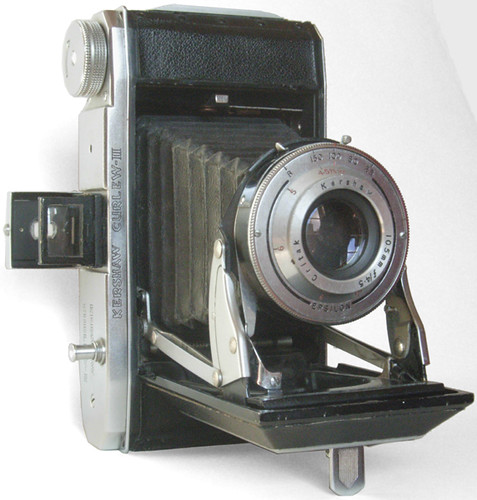Difference between revisions of "Kershaw Curlew"
m (name expansion) |
(image added) |
||
| Line 1: | Line 1: | ||
| − | + | {{Flickr_image | |
| − | |image_source= | + | |image_source= http://www.flickr.com/photos/24225011@N04/2951849888/in/pool-camerapedia/ |
| − | |image= | + | |image= http://farm4.static.flickr.com/3200/2951849888_b087f1ee10.jpg |
| − | |image_align= | + | |image_align= left |
| − | |image_text= | + | |image_text= Curlew II |
| − | }} | + | }} |
The '''Kershaw Eight-Twenty Curlew''' is a heavily-built [[folding]] camera taking eight 6x9cm exposures on [[120 film|120 rollfilm]]. | The '''Kershaw Eight-Twenty Curlew''' is a heavily-built [[folding]] camera taking eight 6x9cm exposures on [[120 film|120 rollfilm]]. | ||
[[Kershaw-Soho|Kershaw]] of Leeds, England, prototyped the Curlew in 1947, but production ran from 1950-1952. | [[Kershaw-Soho|Kershaw]] of Leeds, England, prototyped the Curlew in 1947, but production ran from 1950-1952. | ||
Revision as of 14:20, 18 October 2008

|
| Curlew II |
The Kershaw Eight-Twenty Curlew is a heavily-built folding camera taking eight 6x9cm exposures on 120 rollfilm. Kershaw of Leeds, England, prototyped the Curlew in 1947, but production ran from 1950-1952. Less than 300 Curlews were made in total[1] - over three models:
| Model | Lens | Shutter |
| Curlew I | Kershaw Critak 105mm f6.5 | 3-speed |
| Curlew II | Kershaw Critak 105mm f4.5 | Epsilon, 4-speed, 1/25-1/150 |
| Curlew III | Taylor Hobson Roytal 105mm f/3.8 | Talykron 1s-1/400 |
| Curlew III | Taylor Hobson Roytal 105mm f/4.5 | Epsilon 1/25-1/150[2] |
Models II & III have double-exposure prevention; the III has a frame-measuring device to stop winding at the correct point - which adds a small switch to the back of the top-plate, marked FREE/LOCK. The name and model is inscribed both on the top plate, behind the shutter release, and on the front - below the viewfinder. The top plate has a flip-up optical viewfinder, with a "ready to expose" indicator, showing black when winding is required and red when ready. The back door is plain except for an octagonal red window, with a thumb-knob-operated internal cover. The folding bed is released by a large button in the base. The film spools sit in hinged carriers to aid insertion and removal.
Links
- Curlew II article by Adam Costello
- Curlew II photo by Phill Brown